
The following discussion will provide both the athlete and coach, with fundamental background information as well as practical hints to ensure "the delivery of the promises of lactate testing". This section will discuss the factors that can affect a result and emphasize the importance of consistency.
It is important that the coach and athletes know which factors affect test results. If a coach performs a test on a hot humid afternoon on wet grass after two days of easy workouts will the results be different if the same test was given on a dry cold windy morning on a cinder track the day after a major competition. The answer is of course it will be different. The next questions is "which of these factors affected the results of the test?" The answer is they all did but not in the same way.You notice I did not say lactate tests in the above paragraphs. Every type of test will be affected by the above factors whether it is a time trial, a heart rate measurement, perceived effort or other measures that coaches use. To win you must test. To test you must be consistent. So to win or excel you should pick the most appropriate tests you can find that you can control.
The important point is to be consistent from one test to the next. It is impossible to pick the ideal testing environment but at least the coach and athlete can try to pick a consistent situation for each test. This does not mean you cannot test because the test environment may never be the same. If you do not test, athletes will never reach their potential because they will never get the feedback necessary to improve. To use a Freudian phrase, those who do not test "are in denial."
The following is a series of examples of how various factors affect lactate tests. These are meant to show the coach and athlete 1) how different testing environments can affect a result and 2) the value of being consistent.
Test results are only valid for the sport discipline practiced during the test. So, test results from a cycling test can not be used to evaluate the athlete's swimming or running profile. One should never try to extrapolate test results from one sport discipline to the other. Each sport uses different muscles and requires completely different technique.Example 1A - An elite swimmer was tested over a period of 4 years in running and in swimming. No difference in endurance capacity (maximal VO2 uptake) of the athlete was seen in the run test while dramatic fluctuations of the endurance capacity(maximal VO2 uptake) were observed in the swim test. The changes of the swim test corresponded with performance changes in swimming. (Lower maximal VO2 uptake correlated with slower performances in competition in the respective periods.)
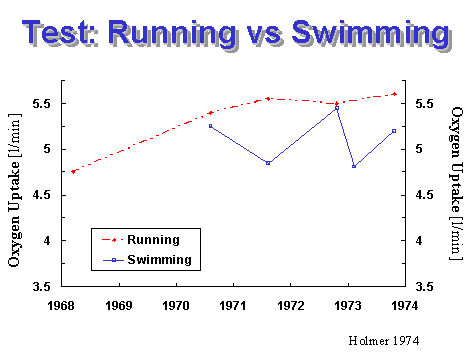
Example 1B - Another study showed that the maximal oxygen uptake (VO2 max) of runners tested on a cycle-ergometer remains under the values observed during their treadmill test.
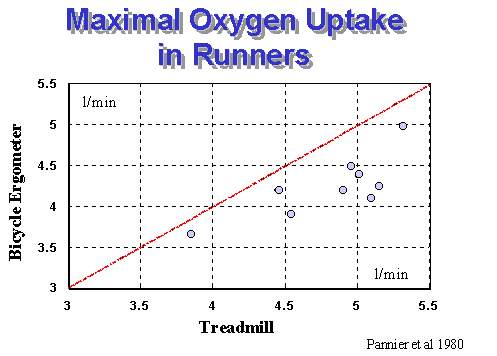
If you really need a 100% comparable test outcome, then you are forced to do a lab test in order to avoid a changing environment (temperature, humidity, etc) and other interactions that may affect field test results. Also more complicated measurements or academic research designs may require testing in a lab.However, if a coach or athlete wants information for a training program, they should test as near as possible to the athlete's training environment. Changing weather and other interactions over seasons will affect the performance possibilities of the athlete but are inherent in the training situation. These interactions must be captured in the results of field tests since they are very important to be taken in account for optimizing your training process. On the other hand the comparability of field test results is less guaranteed due to these changing interactions.
Field tests are clearly imperative and are much more valuable than lab tests for providing training information.
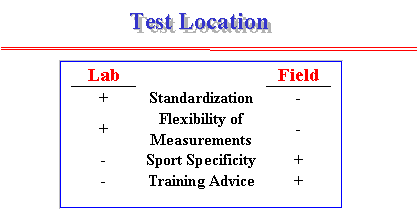
We know that the test procedure has an impact on the results of a lactate test. The accumulation of lactate will happen at an earlier stage in a multiple step test when the rest between the steps is reduced or when the duration of the steps is increased. The oxygen uptake on the other hand is unaffected by changes in the duration of the steps and the rest between the steps.
Example 2A. - In the following experiment several athletes completed three step tests on a treadmill using 3, 5 and 7 minute steps. At every speed, lactate levels are higher after the 7 minute step. For the 3 and 5 minute steps the lactate has not come to an equilibrium at the end of the step so the readings are misleading. Lactate readings are affected by the duration of the step and the increase in effort between steps. Smaller changes in pace or effort between steps will require less time for lactate to come to an equilibrium.
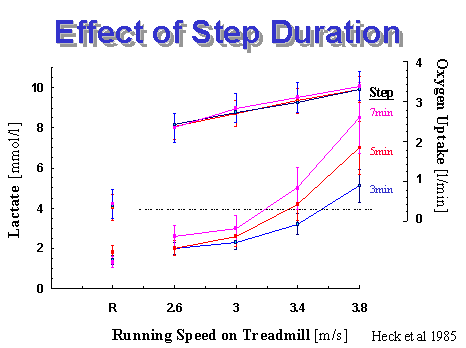
Example 2B. - In a different experiment several athletes completed three step tests on a treadmill but varies the amount of rest between each step. Notice that VO2 measurements are unaffected by the change in step length or rest and thus are a less reliable measure of metabolic conditions.
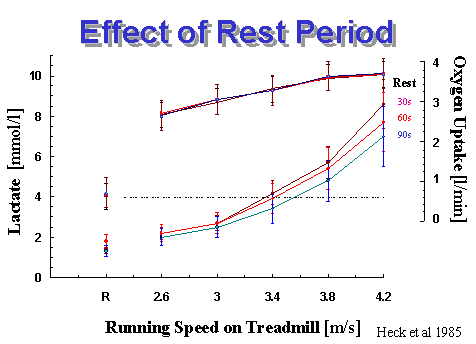
Example 2C. - On the other hand, if we compare the lactate response in a Two-step test (15 minutes rest between sets) with that in a three step test (1 minute rest), it can be observed that the Two-step test, in spite of a complete rest between both steps, provokes an earlier accumulation of lactate compared to a multi-step test.

We have shown that the athlete must test in the sport they are training for and that the structure of the test protocol (length of step and rest between steps) will affect results. The following discussion will point out how other variables can affect results.
Example 3A. Wearing a mask to measure oxygen-uptake during a test increases the lactate levels slightly at each stage of the test. Thus, higher lactate levels will occur at an earlier stage of the test.
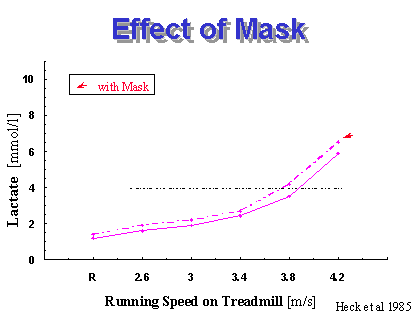
Example 3B. Ground surface has an effect on the lactate test results. Grass is a very healthy surface for run training. However, this surface absorbs a great amount of energy. This leads to an early accumulation of lactate compared to running at the same speed on other surfaces. The most efficient surface to run on at a moderate speed is a metalled sand track.

Example 3C. Also whether the surface is wet or dry will have an influence on the test results. Energy increases dramatically if the grass surface gets wet. When a woodland track is wet, running economy increases. The most neutral surface with respect to wet/dry interactions on lactate test results is a cinder track. Similar results were also found for tartan tracks, for this reason we will recommend that all running lactate tests take place on a tartan track or a similar surface. The tartan track is less slippery after a heavy rain and its surface is unaffected by heavy use. A cinder track can become uneven if not maintained properly.
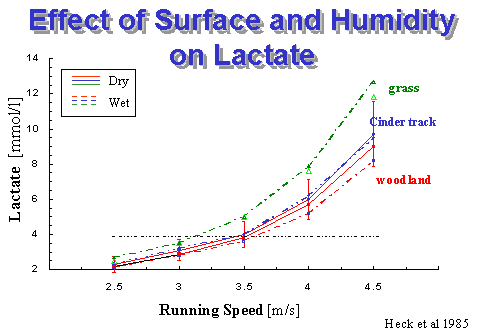
Example 3D. In swimming, the pool length substantially affects the results of a lactate test. The shorter the pool length the less lactate an athlete will develop at a given pace. Since these time variations differ dramatically between swimmers, it is very misleading to estimate for 50 m-pool times from a test in a 25 yd/m-pool. If you are really forced to do so, then it is better to take the differences in the athlete's best time for the same distance in different pools as an adjustment factor (e.g. if the 400m time in 50m-pool is 5 sec slower than in a 25m-pool, then the athlete should add 5sec to the training times calculated on the basis of a lactate test in a 25m-pool. When comparing 25 yard pools to 50 meter pools then an adjustment has to be made for the distance as well.
The preceding examples showed how different elements of the protocol can affect results. However, there are other factors associated with training or the environment that will influence results. It is important to avoid as much as possible these other variables since they will interact with a lactate test. If you don't then this could lead to a misinterpretation of the test results. Such interactions may come from:
- Weight training within 24 hours before the test
- An intensive training session within 24 hours before the test
- Testing within 3 days after an exceptional training period, such as an intensive and/or voluminous training camp
- Testing in the morning versus testing in the afternoon
- Too intensive or too voluminous warming up
- Testing after a complete rest day
We have learned from practice that the lactate response after weight training may be disturbed for as long as 24 hours. Lactate accumulation at a submaximal work load seems to occur at an earlier stage and the lactate concentration after an all-out effort remains under the expected level. Taking such a disturbed lactate response as a reference to determine the actual physical condition profile, the training efficiency and to deduce training guidelines for the coming training period, will certainly be "misleading".
A similar interaction but less pronounced, happens if an intensive water training precedes a lactate test within 24 hours before the test.
Example 4A. If an athlete has just finished a voluminous or intensive training period, the glycogen supply in the athlete's muscles will probably be decreased. This will attenuate the glycolysis activity which is responsible for producing lactate. In such a situation, the lactate production will be decreased and result in a later onset of blood lactate accumulation, but also in a lower max lactate level. The following chart illustrates what can happen after a competition.
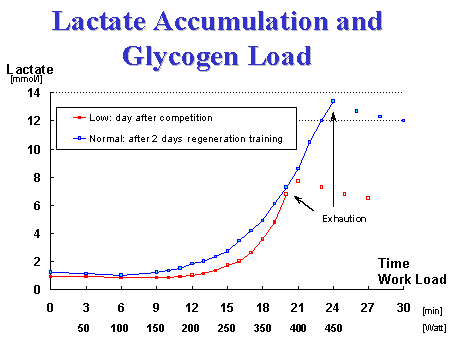
Without knowledge that the test took place a day after a competition this test may give the impression that the athlete improved in endurance. In fact it is not the improvement of oxygen uptake (=real endurance improvement) but a reduced capacity to produce lactate that causes the shift to the right of your lactate curve. So don't plan a lactate test immediately after a competition or heavy training session, but provide a 3 day regeneration period before testing. This will assure that changes in lactate response can be allocated to changes in conditioning.
We have also observed that in the afternoon an athlete can swim about 1 sec/100m faster for the same submaximal lactate concentration as compared to a morning session. This means that lactate tests should always be performed at approximately the same time of day. This is especially true with excellent swimmers where there is not much room for improvement since they are already strong performers. With elite swimmers it is necessary to know that small differences are really due to conditioning changes and are not the consequence of testing at a different time of day.
Example 4B. The following chart shows three things that can affect lactate tests. These are:
- there are differences in lactate accumulation between morning and afternoon for swimmers. Consequently, don't test early in the morning.
- excessive warm-up can depress lactate results. If the warm up before the test takes too long (more than 60 minutes) lactate after a sub maximal effort will be lower when compared to a normal warm-up.
- Avoids sprints before a test. Even a simple sprint before a a sub maximum test will induce higher lactate after the next sub-maximal swim.

If all these variables that interact with the test have to be avoided, then the coach or athlete has to plan lactate tests well in advance. It is even preferable to plan lactate tests at the same time as the coach or athlete is planning important training sessions and rest phases, i.e the phasing of the macrocycle. One of the advantages of lactate testing is that it will not only provide an education for the athlete and coach but it will also impress upon the athlete the importance of timing of certain types of training. Too many athletes just do what seems to be best for them at the moment and don't plan their training in advance.
As a consequence, lactate tests have to be planned well in advance (together with phasing of the macrocycle) and preferably during a relative rest week or in the first week after a relative rest week. In addition all interactions as mentioned above should be avoided if possible or taken into account. However, training has the highest priority. This means that lactate tests are scheduled around the training program, but never change a training program to schedule a lactate test.
- Keep test procedures as constant as possible,
- Test in the same length swimming pool as where training takes place. (It's all right to test in a 25 meter swimming pool and train in a 25 yard pool but don't test in a 50 meter pool and train in a 25 yard pool or the reverse.)
- Carry out the run test in dry conditions and on a tartan track
- Avoid non-protocol related factors that can interact with lactate results. (weight training or intensive water training within 24 hours, other recent heavy workouts or camps, early morning testing, long warmups etc.) It is advisable to test after a rest day or a day of easy workouts.
- Plan lactate tests well in advance (together with phase of the macrocycle) to avoid those factors that could interact with the test.
Again we repeat that these precautions are appropriate for any form of testing not just lactate tests.
Questions, Comments and Ordering Information:
1-800-462-2876 (U.S.A. and Canada)
1-914-747-8572 | 1-914 -741-5623 (fax)
email: info @ lactate.com